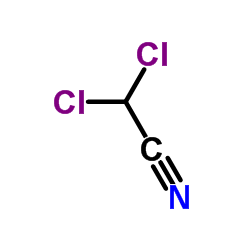Excretion and tissue disposition of dichloroacetonitrile in rats and mice.
M R Roby, S Carle, M A Pereira, D E Carter
Index: Environ. Health Perspect. 69 , 215-20, (1986)
Full Text: HTML
Abstract
The excretion and tissue distribution of [1-14C]dichloroacetonitrile and [2-14C]dichloroacetonitrile were studied in male Fischer 344 rats and male B6C3F1 mice. Three dose levels of dichloroacetonitrile (DCAN) (0.2, 2, or 15 mg/kg) were administered to rats and two dose levels of DCAN (2 or 15 mg/kg) to mice. Daily excreta including exhaled volatiles and radiolabeled carbon dioxide (14CO2) were analyzed for radiolabeled carbon (14C) until greater than 70% of the radioactivity was excreted. At that time the animals were sacrificed and tissues were collected. Tissues and excreta were analyzed for 14C by combustion and liquid scintillation counting. Rats administered [1-14C]DCAN excreted 62 to 73% of the 14C in 6 days, with 42 to 45% in urine, 14 to 20% in feces, and 3 to 8% as CO2. Rats administered [2-14C]DCAN excreted 82 to 86% of the 14C in 48 hr, with 35 to 40% in urine, 33 to 34% as CO2, and 10 to 13% in feces. Mice administered [1-14C]DCAN excreted 83 to 85% of the 14C in 24 hr, with 64 to 70% in urine, 9 to 13% in feces, and 5 to 6% as CO2. Mice administered [2-14C]DCAN excreted 84 to 88% of the 14C in 24 hr with 42 to 43% in urine, 8 to 11% in feces, and 31 to 37% as CO2. Liver tissues retained the most 14C in all studies except the study of [1-14C]DCAN in rats, where blood contained the most 14C. These results indicate that DCAN was absorbed rapidly after oral administration in water. The differences in the route of excretion of [1-14C]DCAN compared to [2-14C]DCAN indicated that the molecule was being cleaved in the body and metabolized by different mechanisms.
Related Compounds
| Structure | Name/CAS No. | Molecular Formula | Articles |
|---|---|---|---|
 |
Dichloroacetonitrile
CAS:3018-12-0 |
C2HCl2N |
|
The formation potential of haloacetonitriles in the Dez Rive...
2014-01-01 [Environ. Technol. 35(17-20) , 2347-55, (2014)] |
|
Genotoxic activity of five haloacetonitriles: comparative in...
2000-01-01 [Environ. Mol. Mutagen. 36(1) , 52-8, (2000)] |
|
Exposure to mutagenic disinfection byproducts leads to incre...
2014-07-15 [Environ. Sci. Technol. 48(14) , 8188-95, (2014)] |
|
Volatile disinfection by-product analysis from chlorinated i...
2009-07-01 [Water Res. 43(13) , 3308-18, (2009)] |
|
Dichloroacetonitrile, a by-product of water chlorination, in...
1991-10-01 [Mutat. Res. 261(2) , 85-91, (1991)] |